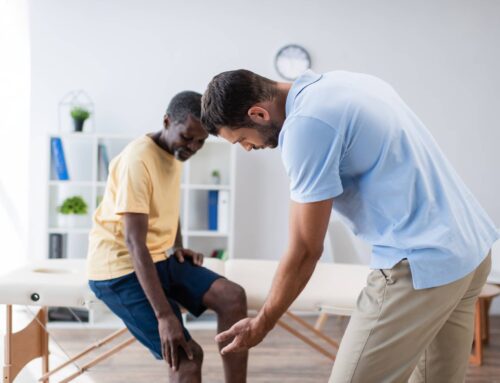Shoulder instability, characterized by a loose or dislocated shoulder joint, can significantly impact one’s quality of life, hindering daily activities and diminishing overall joint function. While traditional treatments such as physical therapy, bracing, and surgical interventions have proven effective to varying degrees, there is a groundbreaking approach on the horizon that holds great promise: stem cell therapy.
Stem cells, often referred to as the body’s “building blocks,” possess the remarkable ability to transform into different types of specialized cells and aid in tissue repair and regeneration. While much attention has been given to their potential in spinal cord injuries and other medical conditions, stem cell therapy is now emerging as a viable option for restoring joint strength and function in shoulder instability.
In this blog post, we will delve into the world of stem cell therapy for shoulder instability, exploring how this innovative medical treatment can help restore stability and function to the affected joint. We will focus on human stem cells, particularly adult stem cell therapy, which utilizes the patient’s own cells for treatment.
The potential applications of stem cell therapy in addressing shoulder instability are wide-ranging. By introducing stem cells into the affected joint, these specialized cells have the potential to promote tissue regeneration, reduce inflammation, and improve overall joint stability. Understanding the effects of stem cells on joint tissue can shed light on how this therapy can aid in restoring strength, function, and stability to the shoulder. Furthermore, we will explore the current state of research and clinical studies surrounding stem cell treatments for shoulder instability. By staying informed about the latest scientific advancements, we can better understand the potential benefits and limitations of this innovative approach.
Join us on this enlightening journey as we uncover the potential of stem cell therapy for shoulder instability. Discover how adult stem cell treatments can offer a novel avenue for restoring joint strength and function, improving your quality of life. Whether you are personally affected by shoulder instability or intrigued by the transformative possibilities of regenerative medicine, this blog post will provide valuable insights into the exciting world of stem cell therapy and its role in addressing shoulder instability.
Understanding Shoulder Instability
Imagine feeling the intense pain and frustration of your shoulder constantly slipping out of place, limiting your ability to enjoy the activities you love – but stem cell therapy could be the answer to restoring strength and function in your joint. Shoulder instability can be caused by various factors such as traumatic injuries, repetitive motion, or genetic predisposition. The shoulder joint relies on a complex system of ligaments, tendons, and muscles to maintain stability. When this delicate balance is disrupted, the joint becomes unstable and prone to dislocation or subluxation.
Traditional treatment options for shoulder instability include physical therapy, bracing, and in severe cases, surgical intervention. However, these methods may only provide temporary relief or have limited success rates. Stem cell therapy offers a promising alternative by harnessing the regenerative power of your body’s own cells. Stem cells can differentiate into various types of tissues including ligaments and tendons, promoting healing and strengthening the damaged structures within the shoulder joint. By using stem cell therapy for shoulder instability, you have an opportunity to regain stability in your joint and return to an active lifestyle without constant fear of dislocation.
Introduction to Stem Cell Therapy
So, you’re curious about stem cell therapy for shoulder instability? Well, let me tell you, it’s quite fascinating! Stem cells are unique cells that have the ability to transform into different types of specialized cells in the body. When used in therapy, they work by regenerating damaged tissues and promoting healing. The benefits of stem cell therapy for shoulder instability are immense as it can restore joint strength and function, providing long-term relief from pain and improving overall quality of life.
What Are Stem Cells and How Do They Work?
To truly understand the potential of stem cell therapy for shoulder instability, you must grasp the concept of what stem cells are and how they function within the body.
- Stem cells are undifferentiated cells that have the ability to develop into different types of specialized cells in the body.
- They can self-renew, meaning they can divide and create more healthy stem cells.
- Stem cells play a crucial role in repairing and regenerating damaged tissues in the body.
The potential applications of stem cell therapy for shoulder instability are vast. By harnessing the regenerative properties of stem cells, this therapy aims to restore joint strength and function by promoting tissue repair and reducing inflammation. However, ethical concerns surround the use of embryonic stem cells due to their origin from human embryos. To address these concerns, scientists have developed alternative sources such as adult stem cells or induced pluripotent stem cells, which do not involve any harm to embryos.
Benefits of Stem Cell Therapy for Shoulder Instability
You can experience the incredible benefits of this innovative treatment, as it revitalizes your shoulder and allows you to effortlessly engage in activities that were once challenging. Stem cell therapy for shoulder instability offers numerous advantages. One major benefit is that it promotes healing by stimulating the growth of new cells, tissues, and cartilage in your shoulder joint. This helps restore joint strength and function, allowing you to regain stability and range of motion.
Additionally, stem cell therapy has a lower risk of complications compared to traditional surgical procedures. Unlike surgery, which requires incisions and a potentially long recovery period, stem cell therapy is minimally invasive and often performed on an outpatient basis. Another advantage is that it provides an alternative treatment option for those who may not be suitable candidates for surgery or prefer a non-surgical approach.
The Stem Cell Therapy Process
To begin the stem cell therapy process, your doctor will first harvest and process stem cells from your own body. This involves collecting a small sample of your bone marrow or fat tissue. Once harvested, the stem cells are then prepared for injection and targeted delivery to the shoulder joint, where they can help restore strength and function.
Harvesting and Processing of Stem Cells
The surgeon deftly extracts the stem cells from the patient’s bone marrow, carefully preparing them for processing. Bone marrow is one of the most common sources of stem cells used in regenerative medicine. These cells have the ability to differentiate into various cell types, making them ideal for repairing damaged tissues in the shoulder joint. Stem cell therapy for shoulder instability has shown promising results in clinical trials, with patients experiencing improved joint strength and function after treatment.
Once harvested, the stem cells are processed to concentrate their numbers and remove any impurities. This ensures that only healthy and viable stem cells are injected back into the affected area. The processing step plays a crucial role in maximizing the therapeutic potential of these cells, allowing them to effectively promote tissue regeneration and restore joint stability.
Injection and Targeted Delivery to the Shoulder Joint
Once harvested and processed, the concentrated stem cells are skillfully injected into the affected area of the shoulder joint, ensuring targeted delivery for optimal tissue regeneration and stability. This intra-articular delivery is a key component of the regenerative medicine approach used in stem cell therapy for shoulder instability. Here’s how it works:
- Precision placement: The stem cell injections are carefully administered using advanced imaging techniques, such as ultrasound or fluoroscopy, to precisely target the damaged area within the shoulder joint. This ensures that the types of stem cells are delivered exactly where they are needed most.
- Enhanced healing environment: Once injected, the concentrated stem cells create an ideal environment for tissue regeneration by releasing growth factors and cytokines. These bioactive molecules stimulate local cells to proliferate and differentiate, promoting healing and repair.
- Long-lasting effects: By directly delivering the stem cells into the joint space, their regenerative potential is maximized. The treatment not only addresses current instability but also helps prevent future recurrence by promoting stronger ligamentous and cartilaginous structures.
Intra-articular delivery of concentrated stem cells offers a targeted and effective approach to restoring strength and function in shoulders affected by instability.
Future Directions and Considerations
Furthermore, advancements in stem cell therapy hold promise for enhancing shoulder stability and improving overall joint health. As researchers continue to explore the potential of this innovative treatment, there are several future directions and ethical considerations that need to be addressed:
- Regulation: Establishing standardized protocols and guidelines for stem cell therapy in treating shoulder instability is crucial to ensure patient safety and promote consistent results.
- Optimal Cell Source: Identifying the most effective source of stem cells for shoulder instability treatment remains a key focus. Research is ongoing to determine whether autologous (patient’s own) or allogeneic (from another donor) stem cells yield better outcomes.
- Delivery Methods: Developing improved delivery methods, such as targeted injections or tissue engineering techniques, can enhance the precision and effectiveness of stem cell therapy for shoulder instability.
- Ethical Considerations: Balancing the benefits of stem cell therapy with ethical concerns regarding informed consent, potential risks, and access to treatment is essential as this field progresses.
By addressing these future advancements and ethical considerations, researchers can pave the way for safer and more effective stem cell therapies for shoulder instability, ultimately restoring joint strength and function.
Final Thoughts
Stem cell therapy offers a promising solution for shoulder instability. By harnessing the regenerative power of stem cells, this treatment aims to restore joint strength and function. Through the use of advanced techniques, such as injection or implantation of stem cells, patients can experience significant improvement in their condition. Success stories from individuals who have undergone this therapy further highlight its effectiveness. As research continues and technology advances, the future looks bright for this innovative approach to treating shoulder instability.





